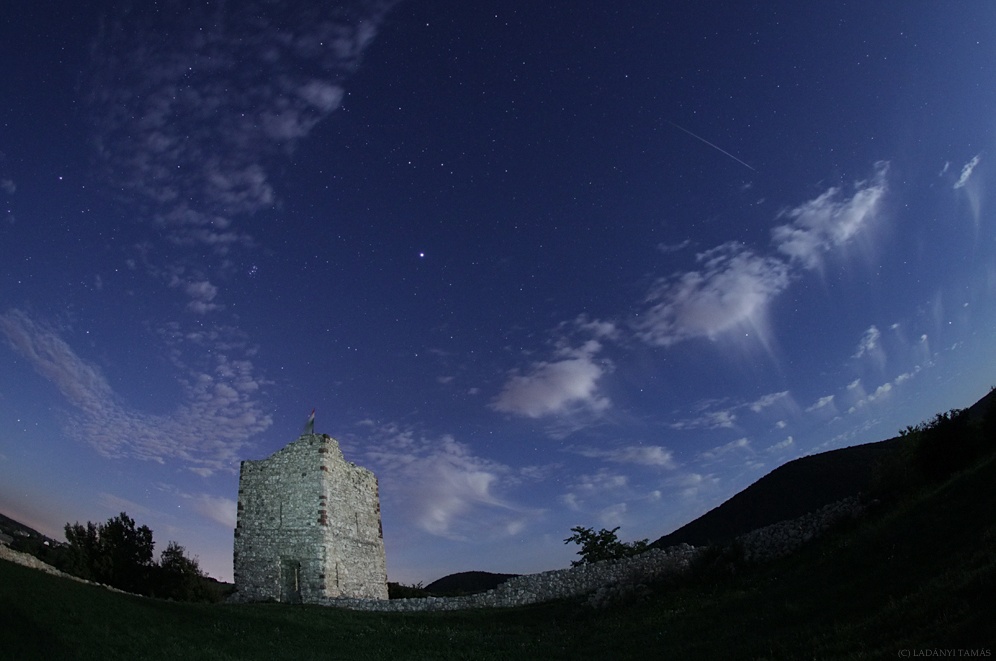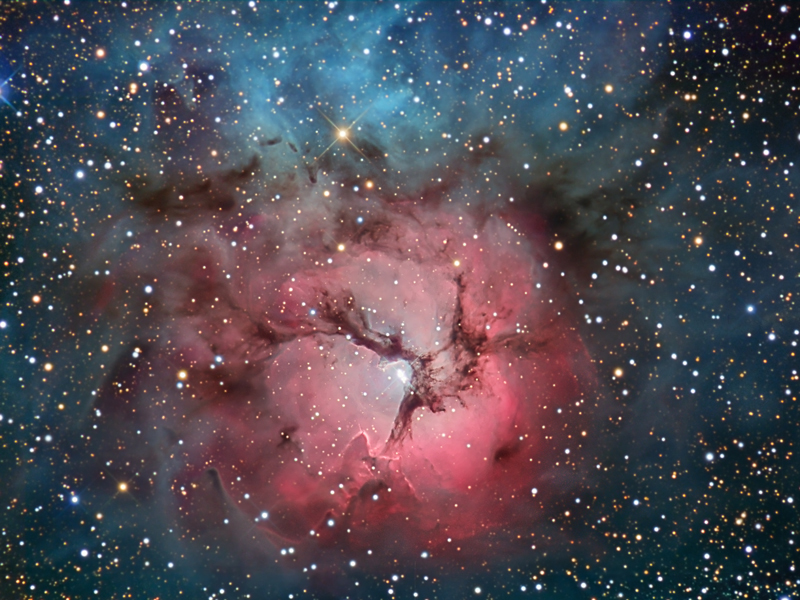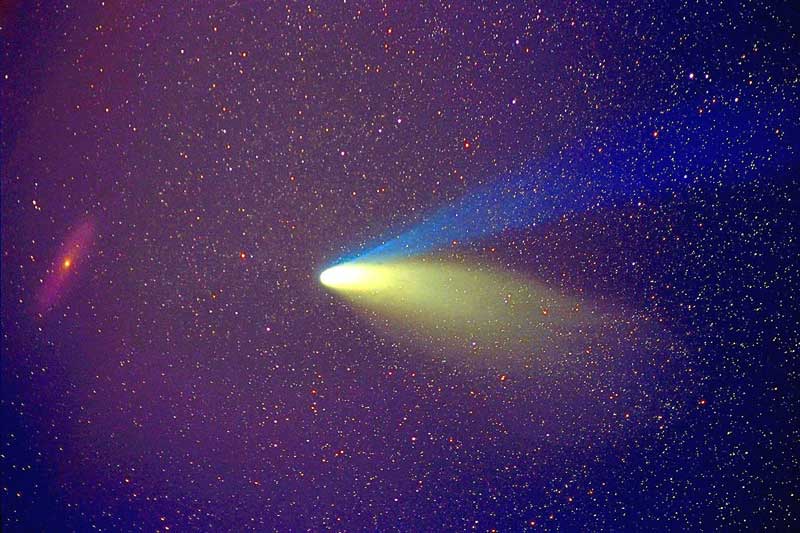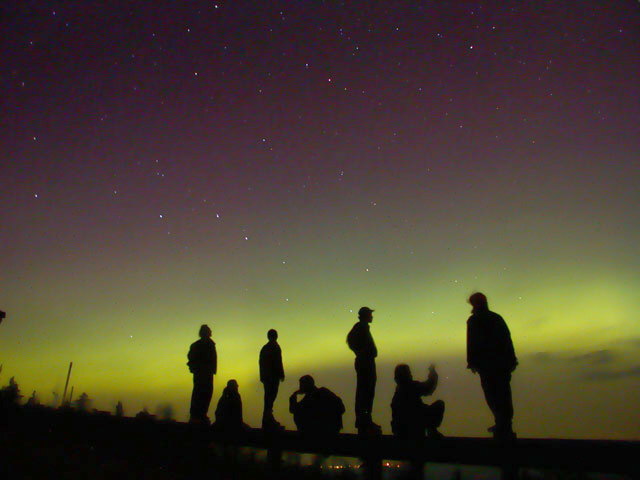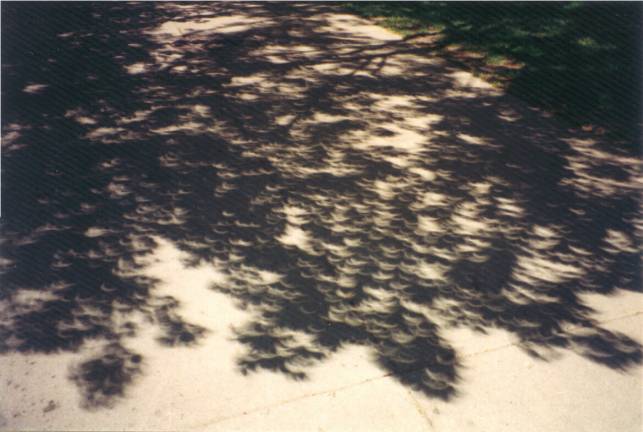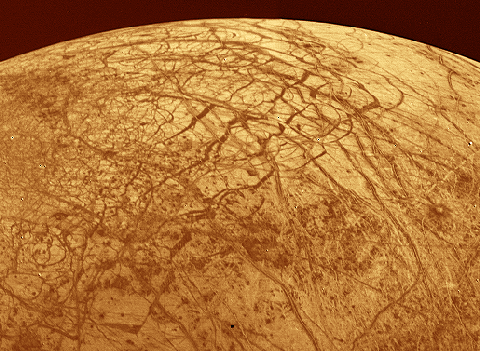| << Previous | Index | Next >> |
2015 Have you watched the Perseid meteor shower? Though the annual shower's predicted peak was last night, meteor activity should continue tonight (August 13/14), best enjoyed by just looking up in clear, dark skies after midnight. Of course, this year's Perseid shower has the advantage of being active near the August 14 New Moon. Since the nearly New Moon doesn't rise before the morning twilight many fainter meteors are easier to spot until then, with no interference from bright moonlight. The Perseid meteor shower last occurred near a New Moon in 2013. That's when the exposures used to construct this image were made, under dark, moonless skies from Hvar Island off the coast of Croatia. The widefield composite includes 67 meteors streaming from the heroic constellation Perseus, the shower's radiant, captured during 2013 August 8-14 against a background of faint zodiacal light and the Milky Way. The next moonless Perseid meteor shower will be in August 2018.
2014
2013
[imghover6=http://apod.nasa.gov/apod/image/1308/pe ... al_960.jpg]http://apod.nasa.gov/apod/image/1308/pe ... labels.jpg[/imghover6]Image Credit & Copyright: Darryl Van Gaal; Annotation: Judy Schmidt
2012
Click to play embedded YouTube video.
Video Credit: M. A. Aragón (JHU), M. SubbaRao (Adler), A. Szalay (JHU), Y. Yao (LBN, NERSC), and the SDSS-III Collaboration
2011 Each August, as planet Earth swings through dust trailing along the orbit of periodic comet Swift-Tuttle, skygazers enjoy the Perseid Meteor Shower. As Earth moves through the denser part of the comet's wide dust trail this year's shower peaks around 6:00 UT August 13 (this morning), when light from a nearly full Moon masks all but the brighter meteor streaks. Still, Perseid meteors can be spotted in the days surrounding the peak. Moonlight and a Perseid meteor created this gorgeous skyscape, recorded in a simple, single, 10 second long exposure on the morning of August 12. Below the moonlit clouds in the foreground are the ruins of a medieval castle near Veszprem, Hungary, seen against the Bakony mountain range. In the night sky above the clouds, the Perseid meteor's trail is joined by bright planet Jupiter near the center of the frame along with the lovely Pleiades star cluster at the left.
2010 A remarkable telescopic composition in yellow and blue, this scene features a trio of interacting galaxies almost 90 million light-years away, toward the constellation Virgo. On the left, two, spiky, foreground Milky Way stars echo the trio galaxy hues, a reminder that stars in our own galaxy are like those in the distant island universes. Predominately yellow, with sweeping spiral arms and dust lanes, NGC 5566 is enormous, about 150,000 light-years across. Just below it lies small, blue NGC 5569. Near center, the third galaxy, NGC 5560, is multicolored and apparently stretched and distorted by its interaction with NGC 5566. The galaxy trio is also included in Halton Arp's 1966 Atlas of Peculiar Galaxies as Arp 286. Of course, such cosmic interactions are now appreciated as a common part of the evolution of galaxies.
2009 What is this strange rock on Mars? Sitting on a smooth plane, the rock stands out for its isolation, odd shape, large size and unusual texture. The rock was discovered by the robotic Opportunity rover rolling across Mars late last month. Pictured, Opportunity prepares to inspect the unusual rock. After being X-rayed, poked, and chemically analyzed, the rock has now been identified by Opportunity as a fallen meteorite. Now dubbed Block Island, the meteorite has been measured to be about 2/3 of a meter across and is now known to be composed mostly of nickel and iron. This is the second meteorite found by a martian rover, and so far the largest. Vast smooth spaces on Mars and Earth can make large meteorites stand out. Opportunity continues its trip across Meridiani Planum on Mars and is on schedule to reach expansive Endeavour Crater next year.
2008 NGC 6888, also known as the Crescent Nebula, is a cosmic bubble about 25 light-years across, blown by winds from its central, bright, massive star. This beautiful telescopic view combines a composite color image with narrow band data that isolates light from hydrogen and oxygen atoms in the wind-blown nebula. The oxygen atoms produce the blue-green hue that seems to enshroud the detailed folds and filaments. NGC 6888's central star is classified as a Wolf-Rayet star (WR 136). The star is shedding its outer envelope in a strong stellar wind, ejecting the equivalent of the Sun's mass every 10,000 years. The nebula's complex structures are likely the result of this strong wind interacting with material ejected in an earlier phase. Burning fuel at a prodigious rate and near the end of its stellar life this star should ultimately go out with a bang in a spectacular supernova explosion. Found in the nebula rich constellation Cygnus, NGC 6888 is about 5,000 light-years away.
2007 Unspeakable beauty and unimaginable bedlam can be found together in the Trifid Nebula. Also known as M20, this photogenic nebula is visible with good binoculars towards the constellation of Sagittarius. The energetic processes of star formation create not only the colors but the chaos. The red-glowing gas results from high-energy starlight striking interstellar hydrogen gas. The dark dust filaments that lace M20 were created in the atmospheres of cool giant stars and in the debris from supernovae explosions. Which bright young stars light up the blue reflection nebula is still being investigated. The light from M20 we see today left perhaps 3000 years ago, although the exact distance remains unknown. Light takes about 50 years to cross M20.
2006 The Moon almost ruined this photograph. During late March and early April 1997, Comet Hale-Bopp passed nearly in front of the Andromeda Galaxy. Here the Great Comet of 1997 and the Great Galaxy in Andromeda were photographed together on 1997 March 24th. The problem was the brightness of the Moon. The Moon was full that night and so bright that long exposures meant to capture the tails of Hale-Bopp and the disk of M31 would capture instead only moonlight reflected off the Earth's atmosphere. By the time the Moon would set, this opportunity would be gone. That's why this picture was taken during a total lunar eclipse.
2005 A supernova explosion, a massive star's inevitable and spectacular demise, blasts back into space debris enriched in the heavy elements forged in its stellar core. Incorporated into future stars and planets, these are the elements ultimately necessary for life. Seen here in a false-color x-ray image, supernova remnant SNR 0103-72.6 is revealed to be just such an expanding debris cloud in neighboring galaxy, the Small Magellanic Cloud. Judging from the measured size of the expanding outer ring of shock-heated gas, about 150 light-years, light from the original supernova explosion would have first reached Earth about 10,000 years ago. Hundreds of supernova remnants have been identified as much sought after astronomical laboratories for studying the cycle of element synthesis and enrichment, but the x-ray data also show that the hot gas at the center of this particular supernova remnant is exceptionally rich in neon and oxygen.
2004 Enjoying the bright Moon's absence from early morning skies, observers around the world reported lovely displays during this year's Perseid meteor shower. As anticipated, peak rates were about one meteor per minute. Though most Perseids were faint, this bright and colorful fireball meteor flashed through skies over Japan on August 12 at 0317 JST. Ending at the upper right, the meteor's trail points down and to the left, back to the shower's radiant point between the constellations of Perseus and Cassiopeia, seen here just above the tower structure in the foreground. The Pleiades star cluster is also visible well below the meteor's trail. Perseid shower meteors can be traced to particles of dust from the tail of comet Swift-Tuttle. The comet dust impacts the atmosphere at speeds of around 60 kilometers per second. While this annual shower's peak has come and gone, Perseid meteors should still be visible over the next few nights, but at a greatly reduced rate.
2003 Have you seen Mars lately? As Earth and Mars near their closest approach in nearly 60,000 years on August 27, the red planet has begun to appear dramatically bright and show interesting details through telescopes and binoculars. Although not yet visible at sunset, Mars can be seen rising increasingly earlier in the evening. Once above the horizon, Mars is easy to spot, as it sports a distinct orange-red hue and it is the brightest object in the sky after the Sun, the nearby Moon, and Venus. After Earth overtakes Mars in their respective solar orbits, Mars will be visible right from sunset, although its historic brightness will then begin to fade. Pictured above, Mars was captured rising in the south east next to Poodle Rock in Valley of Fire State Park, Nevada, USA.
2002 Have you contemplated your sky recently? Last night was a good one for midnight meditators at many northerly locations as meteors from the Perseid meteor shower frequently streaked through. The Perseid meteor shower has slowly been building to a crescendo but should continue to be rewarding tonight and into the week. Pictured above on August 1, a group of celestial sightseers near Quebec, Canada are treated to a dark and wondrous night sky that contained bright stars, green auroras, the band of our Milky Way galaxy, a majestic Moon rising, the International Space Station slowly gliding by, and the occasional flash of a Perseid meteor. Although no meteors were caught in this frame, the Big Dipper remained quite prominent.
2001 The dust that pervades our Solar System is not the dust that pervades our homes. Solar System dust comes from comets and asteroids, whereas house dust is most likely lint or dead cells. Pictured above is a piece of interplanetary dust caught by a high-flying U2-type aircraft. It likely originates in the early days of our Solar System, being stored and later ejected by a passing comet. The particle is composed of glass, carbon, and a conglomeration of silicate mineral grains. It measures only 10 microns across, a tenth the width of a typical human hair. NASA's STARDUST mission, launched in 1999, is scheduled to pass through the tail of Comet Wild 2 in 2004 and return many more interstellar dust samples to Earth in 2006.
2000 Eta Carinae may be about to explode. But no one knows when - it may be next year, it may be one million years from now. Eta Carinae's mass - about 100 times greater than our Sun - makes it an excellent candidate for a full blown supernova. Historical records do show that about 150 years ago Eta Carinae underwent an unusual outburst that made it one of the brightest stars in the southern sky. Eta Carinae, in the Keyhole Nebula, is the only star currently thought to emit natural LASER light. This image, taken in 1996, resulted from sophisticated image-processing procedures designed to bring out new details in the unusual nebula that surrounds this rogue star. Now clearly visible are two distinct lobes, a hot central region, and strange radial streaks. The lobes are filled with lanes of gas and dust which absorb the blue and ultraviolet light emitted near the center. The streaks remain unexplained. Will these clues tell us how the nebula was formed? Will they better indicate when Eta Carinae will explode?
1999 Near the shadow of the moon under a shady tree, dozens of images of a 1994 solar eclipse in progress are visible in this striking picture from the campus of Northwestern University in Evanston, Illinois. What creates the multiple images? Any small gap between leaves can act like a pin-hole camera, projecting a discernible image of the crescent sun onto the shaded sidewalk below. This tree's height and multitude of leaves combine dramatically to produce the large size and number of images. On August 11, many throughout Europe and Asia had the chance to enjoy similar views of the last total solar eclipse of the millennium as the moon's shadow raced across densely populated regions of the globe.
1998 While orbiting the planet during their June 1998 mission, the crew of the Space Shuttle Discovery photographed this view of two moons of Earth. Thick storm clouds are visible in the lovely blue planet's nurturing atmosphere and its largest artificial moon, the spindly Russian Mir Space Station, can be seen above the planet's limb. The bright spot to the right of Mir is Earth's very large natural satellite, The Moon. The Mir orbits planet Earth once every 90 minutes about 200 miles above the planet's surface or about 4,000 miles from Earth's center. The Moon orbits once every 28 days at a distance of about 250,000 miles from the center of the Earth.
1997 Most stars appear only as points of light. Recently, Betelgeuse became the second star, after our Sun, to have it surface resolved. Now add Mira to the list. Mira A is a red giant star undergoing dramatic pulsations, causing it to become more than 100 times brighter over the course of a year. Mira was discovered to be the first variable star 401 years ago today by David Fabricus. Mira can extend to over 700 times the size of our Sun, and is only 400 light-years away. The above photograph released last week from the Hubble Space Telescope shows the true face of Mira. But what are we seeing? The unusual extended feature off the lower left of the star remains somewhat mysterious. Possible explanations include gravitational perturbation and/or heating from Mira's white dwarf star companion.
1996 Voyager spacecraft images of Europa's surface, like the one above, are suggestive of sea ice on Earth. The criss-crossing dark streaks may indeed be cracks in its ice-covered surface caused by Jupiter's tidal stresses accompanied by the freezing and expansion of an underlying layer of water. This tantalizing prospect of oceans of liquid water beneath its frozen surface has helped make the smallest of the Galilean moon's of Jupiter a planned focus of the Galileo spacecraft's ongoing mission to explore the Jovian system. New Europa images and results from the Galileo mission were released today revealing details which further suggest that Europa's icy surface was once - and may still be - supported on slush or liquid water.
1995 The sun was captured in 1973 throwing one of the largest eruptive prominences ever recorded. Sol, our sun, is a normal star. It formed about 5 billion years ago, and will last about another 5 billion years. The sun will never explode, and a solar flare will never destroy the earth. Eventually the sun will become a white dwarf star. The sun is made of mostly hydrogen and helium. The sun's center is so hot that when hydrogen nuclei collide, they stick together and release energy - a process called nuclear fusion No one knows why the center of the sun emits so few neutrinos.
| << Previous | Index | Next >> |


